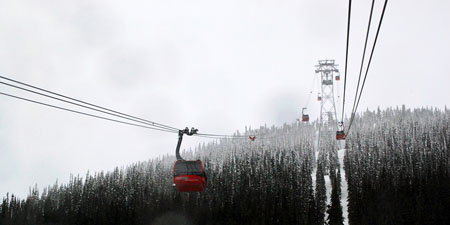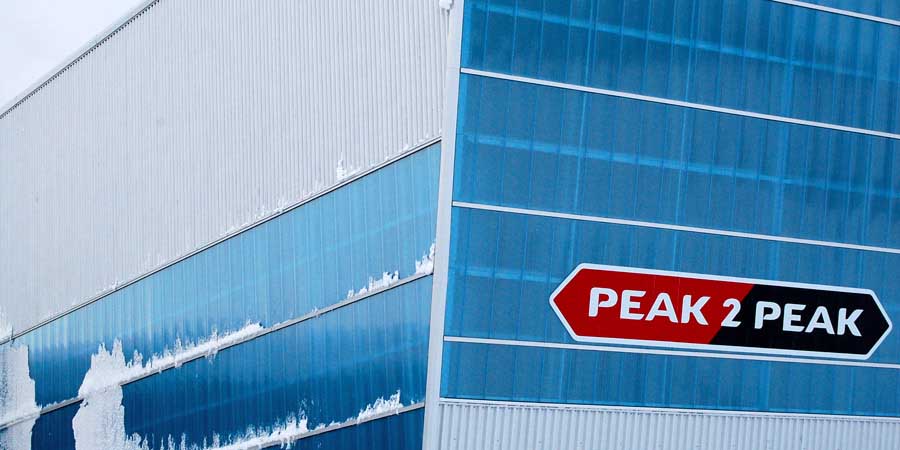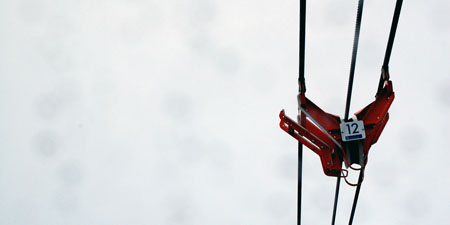Last month I toured Whistler’s Peak 2 Peak cable gondola system. This is a 3-part series on the system. Part 1 is necessarily technical in nature and will refer back to several pages of The Gondola Project for those unfamiliar with cable technology.
With small, incremental baby-steps, cable transit continues to push its capabilities beyond what people traditionally expect of it.
Whistler, British Columbia’s Peak 2 Peak, however, is not so much incremental as it is an innovative leap forward for the technology. One of my former university professors, after having ridden the system, described it to me as an “incredibly impressive machine.”
(Somehow referring to it simply as “a machine” doesn’t quite do it justice, but that professor was never easily impressed anyways.)
The Peak 2 Peak was initially conceived by the proprietor’s of the Whistler-Blackcomb ski resort as a method of shuttling skiers and hikers between the tops of the resorts two major mountains (Whistler and Blackcomb).
You can’t help but question the logic of this: Skiers (the primary users of this system) use a gondola to get up a mountain so that they can ski down the mountain. As both the Whistler and Blackcomb Mountains each have their own gondola systems, why would a skier need to use the Peak 2 Peak at all?
Nevertheless, the novelty of the system attracts strong ridership and since it’s opening in early 2009, the Peak 2 Peak has become an attraction in it of itself.
At it’s highest point, the cable is 436 m above the valley floor, which (for comparison) is about the height of Chicago’s Sears Tower. And yet there’s virtually no vertical rise. The Peak 2 Peak is an almost completely horizontal system.

The Peak 2 Peak experiences virtually no vertical rise from station to station. Image by Steven Dale.
While the height of the system is impressive, it’s the valley crossing that garners most attention. While most cable systems would require several intermediary towers to accomplish a 3 km long valley crossing, the Peak 2 Peak does so without a single intermediary tower. This is the longest unsupported cable span in the world and the Peak 2 Peak owes its fame to this very feature.
Massive, unsupported spans such as this were impossible before the recent 3S innovation. Much like the technology behind Innsbruck’s Hungerburgbahn, 3S technology is a hybrid fusion of two separate cable technologies. But while the Hungerburgbahn fused funiculars and gondolas, the 3S is a hybrid of aerial trams and gondolas.
Aerial trams have a high speed, excellent wind stability and large vehicles. They are also expensive. The Portland Aerial Tram and the Roosevelt Island Tram are two very good examples of this technology. The trouble with aerial trams is they are not detachable systems and that causes their overall capacity to decrease. Corner-turning is impossible. It’s a high-cost, low-value technology.
Gondolas, meanwhile, have modest speeds, smaller vehicles and modest wind stability, but are detachable. This detachability increases system capacity, lowers wait times and allows for corner-turning.
The 3S, therefore fuses the benefits of both technologies while eliminating the deficiencies of each. The Peak 2 Peak runs on two individual and stationary support cables while it is propelled by a third separate moving cable. It is basically like a Bicable system with a second support cable. This second support cable allows 3S technology to carry vehicles of up to 35 people and operate safely in 100 km/hr winds.
Capacity of the Peak 2 Peak is 2,500 pphpd with 28-person vehicle headways of 49 seconds. Even shorter headways and larger vehicles are possible, driving the capacity of a 3S system above the 4,000 pphpd threshold.
While the Peak 2 Peak does not utilize intermediary stations or corners, those two features are both possible with 3S technology and are sure to be realized in the future. As of yet, however, only a handful of 3S systems are operational across the globe.
Proceed to Part 2 where I discuss station and vehicle design and footprint.



19 Comments
The systems looks interesting, but It seems that the capacity of a car dosn´t go higher than 28 person, and no more of 4000 pphpd. Is it right? Please let me know if there are higher capacity systems in operation and where.
Thank you
Current 3S technology can hit 6,000 – 8,000 pphpd (depending upon whom you ask). Arguably, the Peak 2 Peak and the Koblenz Rheinseilbahn are the two cable systems with the highest offered capacity on the planet (as far as we know), but neither are pushing the technology to its upper limits.
Koblenz Rheinseilbahn have 35 places cars … but these are not technology-limits , these could be pushed far on.
the support ropes of Whistler Peak-to-peak are 56 mm. diameter , same ropes are standard produced up to 100 mm. diametre, (normal use on aerial tramways) multplying more than 3x the load capability.
Its already industrial feasible to have 100 places-car with a 30″ headway = 12.000 pphpd , if its not haven been made, is because ski stations doesn’t (still) need this capability.
And we even not talked about the possibility -unique in the transport world- to have multiple running gondola lines on the same trace and supports…
Do we have evidence of this Giorgio? Would a cable manufacturer have permission from the regulators of the technology to build such a thing?
Where gondola and ropeway are (rather strictly) ruled like in Europe, there isn’t any reference to dimensions or capacity limits . safety rules are the same for 2 or 200 people.
Currently the biggest issues come from the transport of rope – a 90 mm. weights more than 50 kg/metre , 50 ton per km… with reels at the very limit of possible transport .
Probabily we will see 5S gondola in the near future , with 4 support ropes and a traction ropes , thus solving the rope dimension/weight issue.
Found the current record for biggest wire rope:
“Awarded to Redaelli Tecna s.p.a. the Guinness World Record 18/05/2010
18TH May 2010 – Trieste, Italy. Redaelli, the Italian leading manufacturer of speciality steel wire ropes and tensostructures engineering, breaks a new record at international level: the Guinness World Record for the heaviest steel wire rope in the world. The record-breaking Flexpack rope, a compacted non-rotating steel wire rope, is 3020 metres in length, 164 mm in diameter, and weights and unprecedented 361,1 tonnes.”
It seems that we have already some margin to improve…
“You can’t help but question the logic of this: Skiers (the primary users of this system) use a gondola to get up a mountain so that they can ski down the mountain. As both the Whistler and Blackcomb Mountains each have their own gondola systems, why would a skier need to use the Peak 2 Peak at all?”
You obviously haven’t visited Whistler as a skier. Peak 2 Peak is a form of mass transit, not a ski lift. It accomplishes in 10 minutes what took 1 hour+ before.
Although Whistler-Blackcomb is the largest ski area in North America, before P2P it skied like 2 separate resorts. Switching between mountains was impractical because skiing all the way down to Whistler Village and re-uploading on the other mountain would chew up a significant chunk of time. Skiers had to pick one mountain and stay there all day.
P2P opens up the possibility of skiing both mountains in a single day, or transiting to the other mountain to meet friends/family for lunch (which isn’t as uncommon as you might think: Whistler Mountain has all of the resort’s beginner terrain, whereas Blackcomb is the more desirable mountain for advanced/expert skiers).
Also, P2P greatly increases the desirability of lodging/real estate at the Creekside village, which has lift access to Whistler Mountain only (if you wanted to ski Blackcomb you had to take a bus). Nowadays it’s easy for Creeksiders to upload on Whistler and use P2P to ski Blackcomb for the day.
In general, you’re right: ski lifts are for getting up the mountain so you can ski down. But as a resort gets larger and larger, visitors increasingly require transport around the mountain, not just up it. Europe has had this necessity for a while and uses gondolas, funitels, funiculars, and trains to meet their needs. Whistler is arguably the first North American resort that’s grown large enough to face this problem in a significant way. The fact that P2P doesn’t gain/lose altitude isn’t a drawback; in fact, it’s precisely why it’s useful.
This rapid transit is especially valuable while skiing. People are paying $96 a day, or $336 for a family of 4 (assuming one teenager and one child). Considering a ski day is probably only 6 hours or so, that’s $56 an hour. And that doesn’t even count other factors like ski rental, transportation to the slope, hotel, etc.
Erik,
That’s an excellent perspective and one I hadn’t ever really considered – as I’m not the most avid skier in the world. Thanks for opening my eyes to that.